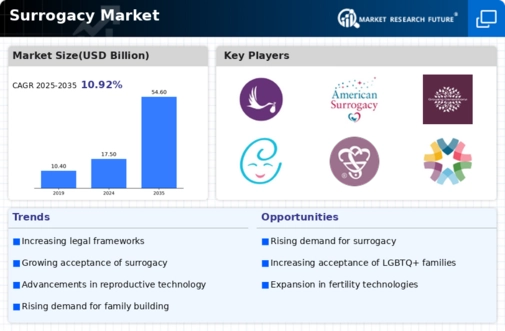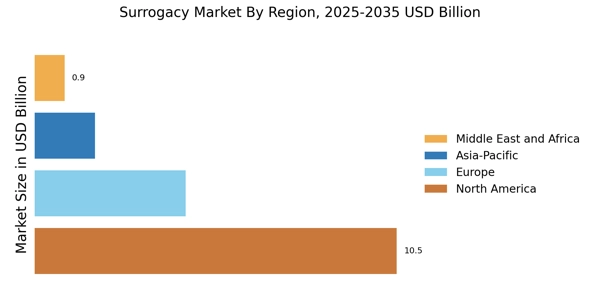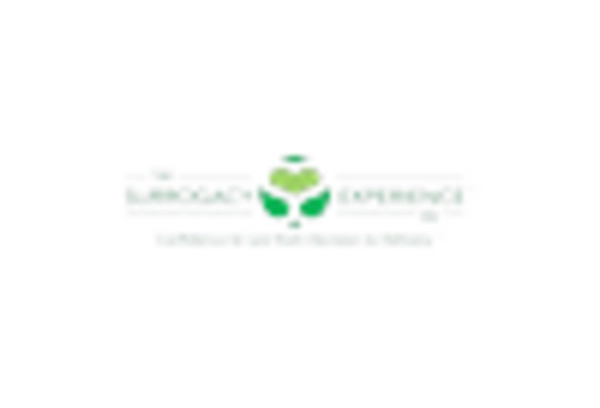Evolving Social Norms
The surrogacy market is witnessing a transformation in social norms surrounding family structures and reproductive choices. As societies become more accepting of diverse family dynamics, including same-sex couples and single parents, the demand for surrogacy services is likely to rise. This shift in perception is fostering an environment where surrogacy is increasingly viewed as a legitimate and desirable option for family building. According to recent surveys, a significant percentage of individuals now support surrogacy as a means to achieve parenthood, indicating a growing acceptance of this practice. The evolving social landscape may encourage more people to explore surrogacy, thereby contributing to the expansion of the surrogacy market. As acceptance continues to grow, it is plausible that the stigma previously associated with surrogacy will diminish, further enhancing its appeal to prospective parents.
Rising Infertility Rates
The surrogacy market appears to be significantly influenced by the rising rates of infertility, which have been reported to affect approximately 15% of couples worldwide. Factors contributing to infertility include lifestyle changes, environmental factors, and advanced maternal age. As more individuals and couples face challenges in conceiving, the demand for surrogacy services is likely to increase. This trend suggests that the surrogacy market may experience substantial growth as more people seek alternative reproductive options. The increasing prevalence of infertility is prompting healthcare providers to offer more comprehensive reproductive services, thereby expanding the surrogacy market. Furthermore, the emotional and financial implications of infertility may drive individuals to consider surrogacy as a viable solution, further solidifying its role in the reproductive landscape.
Increased Awareness and Education
The surrogacy market is benefiting from increased awareness and education regarding surrogacy options. As information becomes more accessible through various channels, including social media and educational platforms, potential parents are becoming more informed about the surrogacy process. This heightened awareness is likely to demystify surrogacy, making it a more attractive option for those facing infertility or other reproductive challenges. Educational initiatives aimed at clarifying the legal, emotional, and financial aspects of surrogacy are essential in fostering informed decision-making among prospective parents. As awareness grows, it is plausible that more individuals will consider surrogacy as a viable path to parenthood, thereby contributing to the expansion of the surrogacy market. The ongoing dialogue surrounding surrogacy is likely to further enhance its visibility and acceptance in society.
Legal and Regulatory Developments
The surrogacy market is increasingly shaped by legal and regulatory developments that govern surrogacy practices. As more countries and regions establish clear legal frameworks for surrogacy, the market is likely to experience growth. These regulations can provide essential protections for all parties involved, including intended parents, surrogates, and children. In jurisdictions where surrogacy is legally recognized, there tends to be a higher demand for surrogacy services, as prospective parents feel more secure in their choices. The establishment of comprehensive legal guidelines may also encourage more individuals to pursue surrogacy, knowing that their rights and responsibilities are clearly defined. As legal landscapes continue to evolve, the surrogacy market may see increased participation from both intended parents and surrogates, fostering a more robust and transparent market.
Technological Innovations in Reproductive Health
Technological advancements in reproductive health are playing a pivotal role in shaping the surrogacy market. Innovations such as in vitro fertilization (IVF), genetic screening, and embryo freezing have revolutionized the way surrogacy is approached. These technologies not only enhance the success rates of surrogacy arrangements but also provide prospective parents with more options and control over their reproductive choices. The integration of advanced reproductive technologies is likely to attract more individuals to consider surrogacy as a feasible option. Furthermore, the surrogacy market is expected to benefit from ongoing research and development in reproductive health, which may lead to even more effective solutions for infertility. As these technologies continue to evolve, they could potentially lower costs and improve accessibility, thereby expanding the surrogacy market.


















Leave a Comment